 Leading Blog | Posts by Month |
 Leading Blog | Posts by Month |
11.30.07

How to Develop Integrative Thinking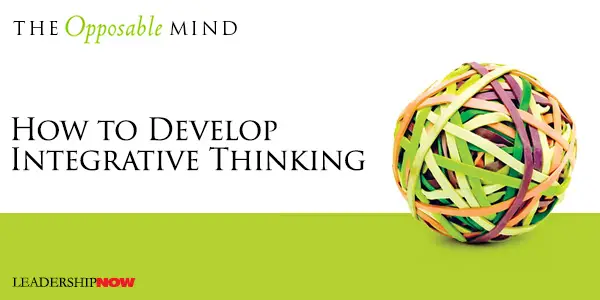
A 2007 study (PDF) conducted by the Center for Creative Leadership found that nearly 92 percent of the executives surveyed believe the challenges their organizations face are more complex than they were just five years ago. Organizations will continually be asked to do even more with less and respond even faster to changes in their industry and economy. Complexity is not going to go away, but developing the skills necessary for integrative thinking as described by Roger Martin in The Opposable Mind (the ability to hold two conflicting ideas in constructive tension) can be an effective way to keep from being sidelined by it. “Integrative thinking is largely a tacit skill in the heads of people who have cultivated, knowingly or otherwise, their opposable minds.” How do we develop integrative thinking? First, we begin by thinking about how we think. Martin writes, “When you refuse to take your thinking for granted, you give yourself the best opportunity to enhance and utilize your opposable mind to its fullest.” By taking a look at your personal knowledge system – how you know what you know – you can get some insight into how you make decisions. Martin has defined three areas, as shown in the diagram below, that guide and inform each other as your experiences grow. Stance: How you see and interact with the world; your philosophy. Martin lists six important ways of looking at the world and self. Tools: Integrative thinkers use generative reasoning (asking what might be instead of what is), causal modeling (considering not only linear and unidirectional relationships but nonlinear and multidirectional relationships as well) and, what I found helpful, assertive inquiry (not argumentative, but pointed questions seeking to find common ground). [Note: There is a great example beginning on page 159 in this regard.] Experiences: Your stance directly affects the kinds of experiences you will accumulate. Structured repetition of a consistent type of experiences develops mastery. Combined with originality, mastery will help you to grow. 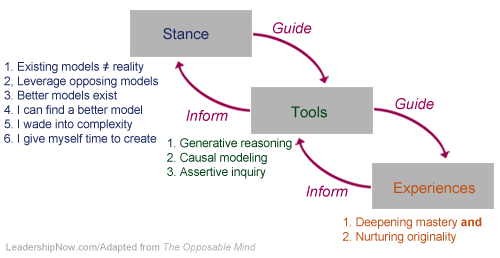 With an understanding of how these areas interact with each other, you can, over time, take an active role in crafting your personal knowledge system. Martin has packed into a short book, a good primer on developing a mind that can grapple with complex issues and find creative solutions that would otherwise be missed. It’s well worth your time. 
Posted by Michael McKinney at 12:08 AM
11.29.07

Out of Context: Everyone is a Leader• "Leadership is how you interact with everyone, including yourself. Leaders are quite visible within large and small business. We tend to think of them as business owners, CEO, and managers at all levels. Traditionally, leadership also extends into politics and other global affairs. However, parents, therapists and health care providers, solopreneurs, sport coaches, consultants, mentors, partners in relationship, teachers, authors, and others who interact with people on a regular basis are all leaders. Everyone is a leader either by choice or default. "If you don’t think of yourself as a leader, then you’re limited in your thinking. Leading is the way we help move people into action, including ourselves. The question is not whether you are a leader, but how well you lead." —Bruce D. Schneider, Energy Leadership
Posted by Michael McKinney at 09:18 AM
11.28.07

Integrative Thinking: The Opposable Mind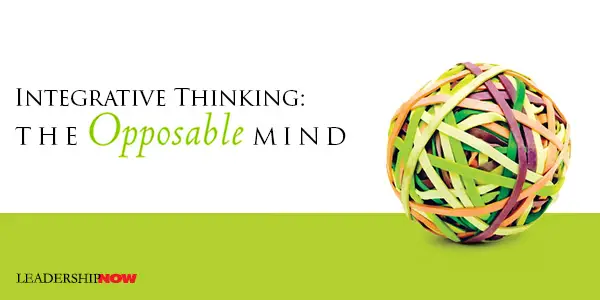 NOT ONE to put the cart before the horse, Roger Martin understands the importance of doing but he prefers “to swim upstream to the antecedent of doing: thinking.” He writes in The Opposable Mind, “My critical question is not what various leaders did, but how their cognitive processes produced their actions.”
NOT ONE to put the cart before the horse, Roger Martin understands the importance of doing but he prefers “to swim upstream to the antecedent of doing: thinking.” He writes in The Opposable Mind, “My critical question is not what various leaders did, but how their cognitive processes produced their actions.”
In examining how exemplary leaders think, he found an approach that was common to many, that he has termed integrative thinking. Integrative thinking is: The ability to face constructively the tension of opposing ideas and, instead of choosing one at the expense of the other, generate a creative resolution of the tension in the form of a new idea that contains elements of the opposing ideas but is superior to each. In other words, integrative thinking examines problems as a whole, taking note of the complexities that exist and embrace the tension between opposing ideas to create new alternatives that take advantage of many possible solutions.
It’s easy to get into the destructive rut of thinking that money is the solution to most problems. School boards are notorious for claiming that their hands are tied because they lack the money they want. They cripple themselves. What they really need are creative solutions. Education is a complex issue and has for too long been subject to tunnel-vision problem-solving. They need integrative thinking. Einstein opined that we should make everything as simple as possible, but no simpler. Too often we try to make complex issues too simple and leave ourselves with too few options based on our limited point-of-view. If we instead embrace complexity and learn to deal with it, we might find more and better solutions. Martin writes, “More salient features make for a messier problem. But integrative thinkers don’t mind the mess. In fact, they welcome it because the mess assures them that they haven’t edited out features necessary to the contemplation of the problem as a whole. They welcome complexity because they know the best answers arise from complexity.” In The Opposable Mind, Martin clearly illustrates this thinking process in action by dissecting varied examples from both business and interpersonal situations. Martin claims that we are all born with an opposable mind—the ability to hold two conflicting ideas or models in constructive tension. “We can use that tension to think our way through to a new and superior idea….Opposing models, in fact, are the richest source of new insight into a problem. We learn nothing from someone who sees the problem exactly as we do.” 
Posted by Michael McKinney at 09:45 AM
11.26.07

5 Leadership Lessons: James M. Kilts on Building the Right Team In his instructive memoir Doing What Matters, James Kilts gives credit to his team for the turnaround he engineered at Gillette. Picking the right people is key to the success of any team. Here are some of his thoughts on building the right team.
Posted by Michael McKinney at 10:46 AM
11.23.07

Why Leaders Don’t ComplimentIn Results that Last, Quint Studer lists six myths and excuses as to why too many leaders resist giving people much needed compliments.
Charles M. Schwab (1862-1939), founder of the Bethlehem Steel Company, said, “I have yet to find the person, however great or exalted his station, who did not do better work and put forth greater effort under a spirit of approval than he would ever do under a spirit of criticism.” In the often cited study by Gerald Graham, Ph.D. of Wichita State University, it found that employees consider personal, immediate recognition by their managers to be one of the most powerful workplace motivators. However, 58 percent of the respondents said their manager rarely, if ever, offered such simple praise. Graham concluded, “It appears that the techniques that have the greatest motivational impact are practiced the least, even though they are easier and less expensive to use.” Who should you be thanking?
Posted by Michael McKinney at 09:41 AM
11.22.07

Out of Context: Quotes on the Art of Leadership• "Businesses need to change their thinking about leadership as the pinnacle of success for everyone and stop doling out leadership jobs as rewards for people who perform very well but simply are not leaders." —Ram Charan, Leaders At All Levels
Posted by Michael McKinney at 01:30 PM
11.21.07

How to Change Anything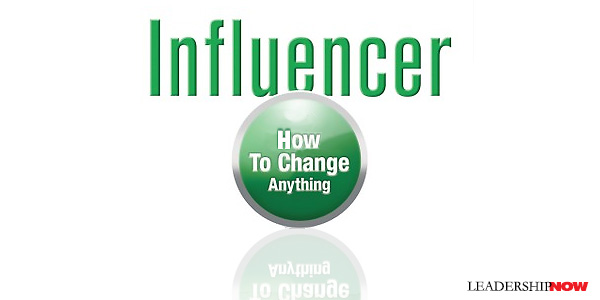
God grant me the serenity to accept the things I cannot change; courage to change the things I can; and wisdom to know the difference. THE authors of Influencer: The Power to Change Anything claim that they can show you how to change anything. Well, nearly everything. They suggest that most of the time we cop out. We comfort ourselves with the Serenity Prayer and move on. Maybe it’s not the courage we lack but the skills to change the things we can. The authors set about to do just that. “If you want to change the world, you eventually have to change how people behave. And if you want to change how they behave, you have to first change how they think.” The key idea is this: “A few behaviors change drive a lot of change.”What that means is, if you want to effect change, then while casting a vision is important (that is, what you want people to achieve), what you need to focus on is behaviors—what you specifically want people to do. If you determine the foundational behaviors upon which everything you want changed stands, and change those things, then everything else changes with it.
There is more than one way to influence and if you are only using one of them as a matter of habit, it may explain why you are having difficulty bringing complex and resistant problems to a solution. There are six sources of influence that drive our behavior divided between two domains—motivation and ability. They reason, “Virtually all forces that have impact on human behavior work on only two mental maps—not two thousand, just two. At the end of the day a person asks, ‘Can I do what’s required?’ and ‘Will it be worth it?’ Influencer presents a model that organizes influence in to 6 general strategies and clearly explains how to make use of these strategies in your own change issues.
Influencer is brought to you by the same group that produced such great books as Crucial Confrontations and Crucial Conversations: Tools for Talking When Stakes Are High. 
Posted by Michael McKinney at 11:53 AM
11.19.07

Reframing Conflict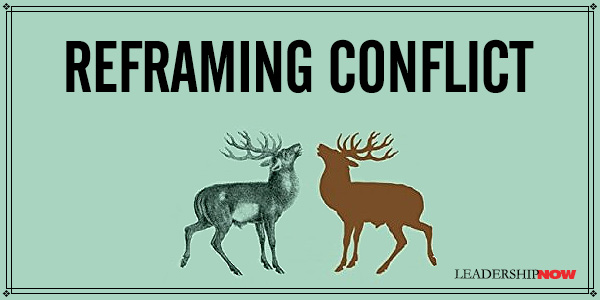
NEGOTIATION expert and Harvard Law School professor, Roger Fisher talks about how we communicate through conflict in Managing Conflict. Reframing the situation we find ourselves in to reflect a concern for he other person’s point of view can move us through a perceived impasse. Fisher’s rethinking process excerpted here, is helpful in this regard: “So I come and try to put myself in your shoes: How do you see it? How can I help you see it in a way that will be helpful to you, where you can go forward? I’m not telling you what to do; I’m not fighting with you.” “I have to get on your side, understand what you’re thinking about; what you’re worried about—your concerns, your interests—and how I can help you deal with your side.” Fisher adds: “Negotiation is recognizing that it’s not just the other side that has the problem but that we have a problem together. When you negotiate, you want to understand each other’s perceptions. How do you see it? How do I see it? How do we change it from adversarial to side by side, so that we’re both working on this?” 
Posted by Michael McKinney at 05:03 PM
11.16.07

America’s Best Leaders: Eighteen Who Motivate People To Work Together To Accomplish Great Things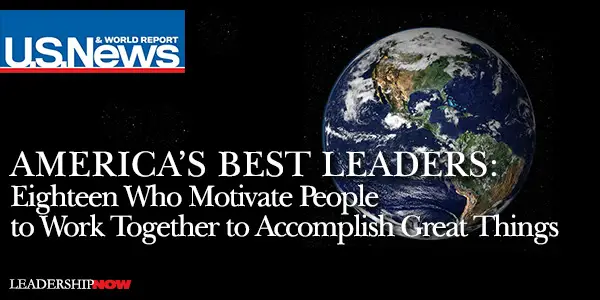 ACCORDING to a recent Center for Public Leadership/U.S. News & World Report poll, "more than three-quarters of the respondents say they believe the country is going through a leadership crisis, up 7 percent from last year, a trend stretching across all demographic and political groups. Nearly 80 percent feel that unless it gets better leaders, the country will decline, while 51 percent believe that the United States is already falling behind other nations. And about two-thirds say that today's leaders pale in comparison with those of 20 years ago."
ACCORDING to a recent Center for Public Leadership/U.S. News & World Report poll, "more than three-quarters of the respondents say they believe the country is going through a leadership crisis, up 7 percent from last year, a trend stretching across all demographic and political groups. Nearly 80 percent feel that unless it gets better leaders, the country will decline, while 51 percent believe that the United States is already falling behind other nations. And about two-thirds say that today's leaders pale in comparison with those of 20 years ago."
Yet, U.S. News has found 18 people—America’s Best Leader—they believe are helping to restore confidence in our leaders. The list is a collaboration between U.S .News and the Center for Public Leadership at Harvard University's John F. Kennedy School of Government. 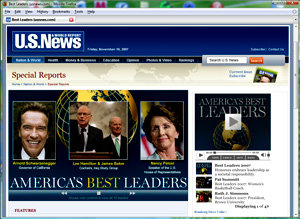 Here is the result:
His foundation builds housing near military hospitals to accommodate soldiers’ families. This list certainly isn’t inclusive and of course, it has its limitations, but it is worth reviewing for some insights into how these individuals developed their leadership skills. The individual profiles/interviews are worth reading.
Posted by Michael McKinney at 07:53 PM
11.15.07

Out of Context: Quotes on the Art of Leadership• "Jealousy and envy are often about comparing our insides to someone else's outsides—a symptom of our externally focused world." —Christine Comaford-Lynch, Rules for Renegades • "The ability to think better will soon become the most significant competative advantage companies and individuals can claim. Thinking better is what it's all about." —Tim Hurson, Think Better
Posted by Michael McKinney at 09:52 AM
11.14.07

Optimizing LuckIn a world of rapidly changing conditions, luck often seems to be the determining factor in the success of the best organizations. According to authors Thomas Meylan and Terry Teays, luck is something that can be optimized and built into your culture. While the chapter on leadership could have benefited from some more rigorous thought, they do outline six behaviors and procedures you can implement to amplify your natural abilities to succeed in any environment. First, and most importantly, they stress the importance of hiring the right people. Look for people with sufficient skills and experience to do the job, aptitudes that will contribute positively to the organization and people with a passion for the kind of work you are hiring them for. (Seek staff reaction to the new person.) “If you don’t have the time to work through a hiring process that gets you the right people, how are you possibly going to have time to deal with all the misfits you end up with?” Secondly, multiply your strengths through the power of delegation – or just let people do their job. If you have hired the right people with the right skill set, then you should be able to trust them to accomplish the task. “Without trust, delegation doesn’t happen. What you get instead is the making of assignments that you either micromanage or snatch back to do yourself.” Third, become adaptable through the “master process of continuous habit management.” This consists of being alert to changes, continuously trying new things until you get the results you want, converting successful behaviors into personal habits and organizational procedures, and discarding obsolete habits when you realize it’s time to create new ones. Fourth, know how to operate in a lean environment before it is forced upon you. “If you have hired self-renewing employees, and you have given them the opportunity and resources to learn new skills, then they are well prepared to adapt to changes in your enterprise’s needs….Don’t think in terms of malnourished drudges. Think of slender gymnasts, flexible and agile and capable of an entire repertoire of tricks.” Fifth, promote prompt and accessible communication to all who need it. Knowledge is the raw material you use to drive a business, it must reach everyone, whether it is good or bad news. “Without good communication habits, your organization may be too slow to take advantage of a surprise opportunity and end up not getting there first.” Finally, build a system for recognizing and rewarding people that perform beyond their job description. “Your method of rewarding employees should encourage the behavior you want your employees to show.” The key passage is this: Differences in levels of success often come down to differences in personal habits. People employ decades-old systems of habits to get through the day. However, most people put no special thought into developing these systems. They pick up a few tricks from mom and dad and a few teachers and a lot from their peers, while growing up and going through school. And that’s where their habit-developing effort stops.
Posted by Michael McKinney at 12:10 AM
11.12.07

Finding the Difference Makers in Your Organization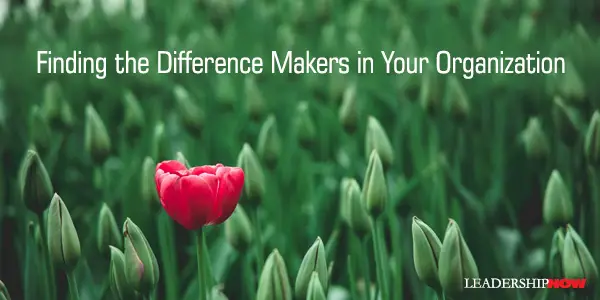
STORIES about people who have gone above and beyond inspire us to be better than we are now. These stories of people who make a difference can help others to see themselves and their work in new ways. Stories help people to disconnect from the moment and project themselves in to a new place where things are possible. Quint Studer writes in Results that Last, “I think difference makers are the world’s real heroes, the people working to make things better. You know who they are: those men and women who give extra effort without thinking of themselves. They may not get a lot of glory, but they are deeply appreciated by the people whose lives they touch.”He suggests that we make a conscious effort to look for and collect the stories of those people that go above and beyond and know when to break the rules in order to make a difference. Then retell them over and over to make them a part of the organization’s culture. The stories should have a behavior-oriented point and help people to connect their situation to that of the heroes in the story. “Finding your heroes and recognizing their behavior is key because recognized and rewarded behavior is repeated.” Here are several ways he suggests we go about finding heroes in our organizations:

Posted by Michael McKinney at 10:43 AM
11.09.07

You Are There: Peter Drucker's Classroom"Everything you see here was as it happened that day, except, You Are There…. What sort of day was it? A day like all days, filled with those events that alter and illuminate our times—and you were there."Reminiscent of Walter Cronkite’s CBS program You Are There, Bill Cohen takes us back into the classroom of Peter Drucker. In A Class With Drucker, he brings to life the energy and humor of one of the best thinker’s of our time. He illuminates some of Drucker’s most profound ideas live, in real time as it were. Subtitled as “the lost lessons of the world’s greatest management thinker,” it is, more to the point, “the lost context of the world’s greatest management thinker.” While many of the ideas are not new to those familiar with Drucker’s teachings, you will find Cohen’s presentation of Drucker’s thinking and classroom elaboration of his ideas, to be enlightening. Drucker taught at Claremont University just a few miles from where I am here. I have had the opportunity to hear him talk and Cohen’s recollections bring back my own experiences. A Class With Drucker is an enjoyable read that shows a side of Drucker that you don’t get from his writings alone. Cohen was the first graduate of the world’s first executive Ph.D. program in management at Claremont University. He reconstructs the lectures that made the strongest impact on him when he was a student, in chapters devoted to 17 key lessons from the Drucker curriculum. In one such chapter entitled, People Have No Limits, Even After Failure, he records Drucker’s problem with Lawrence Peter’s infamous Peter Principle from the 1968 book of the same name: "In a hierarchy every employee tends to rise to his level of incompetence." Cohen writes: Peter [Drucker] said, We have no right to ask people to take on jobs that will defeat them, no right to break good people. We don’t have enough good young people to practice human sacrifice.” The selection of the right person for the right job was the manager’s responsibility. But even more importantly, the notion that people rise to their levels of incompetence was dangerous to the organization.Cohen ends each chapter with a useful Drucker Lesson Summary. Even Drucker aficionados will gain something new here.
Posted by Michael McKinney at 01:19 PM
11.08.07

Out of Context: Gary Hamel on the Post-Managerial Society“We have for many decades been living in a “post-industrial” society. I believe we are now on the verge of a “post-managerial” society, perhaps even a “post-organizational” society. Before you start hyper-ventilating, let me assure you that this doesn’t mean a future without managers. Just as the coming of the knowledge economy didn’t herald the death of heavy industry, a “post-managerial” economy won’t be entirely free of executives, supervisors, administrators and overseers. But it does imply a future in which the “work of management” is less and less the responsibility of “managers.” To be sure, activities will still need to be coordinated, individual efforts aligned, relationships nurtured, objectives decided upon, and knowledge disseminated. But increasingly, this work will be distributed out to those on the periphery.” —Gary Hamel, The Future of Management

Posted by Michael McKinney at 09:10 AM
11.07.07

Your Leadership BrandAccording to Dave Ulrich and Norm Smallwood, leaders must live the image they want to portray to their customers (followers) and investors. That is their leadership brand. They write in Leadership Brand, “Leadership brand occurs when leaders’ knowledge, skills, and values focus employee behavior on the factors that target the issues that customers care about. Leadership brand is an extension of an organization’s brand identity because it shows up in the behaviors and results of leaders throughout the firm in a manner that bridges employee and customer commitment.” In others words, leaders must walk the talk.But it goes beyond that. It is a philosophy that should permeate the whole organization in order to build leaders for future roles in that organization in alignment with that organizations leadership brand. It is something that is done at all levels by all leaders. Leaders who produce leaders “build a leadership brand by cultivating competence, sharing decision making and authority, imparting information, and distributing rewards.” Organizationally, the process begins by asking not “What do I want to be known for?” but, “What do we want our customers to know us for?” Once determined, living that brand becomes a serious matter; one that should be taken with careful consideration. Leadership comes with a price. Leadership requires a great deal from leaders as their behavior is carefully watched and observed by others. The needs of the customers/followers come first. Accountability is not an option. This applies to any organization. Just ask Tom Haggard or Bob Nardelli. The higher up you go the more intense it becomes. The authors quote Gary Hamel who put it this way: Authenticity is a huge multiplier of individual impact. And, at it core, authenticity is not about being true to oneself (whatever that means), it is about being true to the interests of those whose lives you want to improve and change. Mercenaries, careerists, and egomaniacs are me-centered. Great leaders are you-centered. (Nicely put Gary!)What about a personal leadership brand? They take a chapter to outline this question. It begins with the question, “What do I want to be known for?” But it doesn’t stop there. Ever results oriented (Results-Based Leadership, 1999), the authors say that that question needs to be linked to a desired result so that your brand will endure. A brand statement should read something like this: “I want to be known for __________, __________, and __________, so that I can deliver __________ and __________ at work and __________ and __________ outside work.” You then need to ask yourself if your leadership brand aligns with the organization’s leadership brand. If not, something needs to give. Understanding the identity and needs of those you're leading is the driving idea behind the leadership brand. They conclude: First, focus on the outside in instead of the inside out. Outside in means that customer (and investor) expectations should frame, focus, and influence leader behaviors. When leader know and do things that add value to customers, they are more likely to be doing the right thing. Second, focus not only on the personal attributes of a noble or successful leader but on leadership, or the cadre of leaders within you company. Based on these two principles, a leadership brand bridges the firm’s identity in the mind of those outside (customers and investors) with the behavior of its employees.
Posted by Michael McKinney at 09:56 AM
11.05.07

The Art of Winning Others Over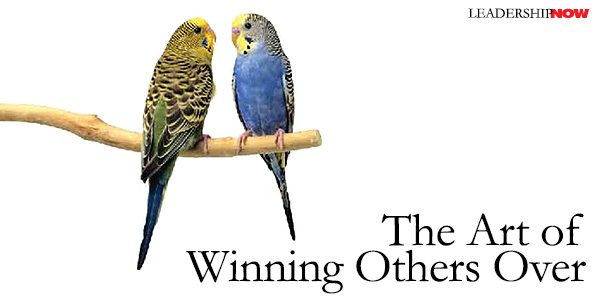
If there is any secret of success, it lies in the ability to get the other person’s point of view and see things from that person’s angle as well as your own. IN The Art of Woo or "Winning Others Over," authors Richard Shell and Mario Moussa, make the case that wooing is one of the most important skills in a manager's repertoire. Research would seem to support this claim as people with strong social skills have been shown to command higher fees and salaries than equally talented but less socially adept colleagues. And they are no doubt more pleasant to be around. Winning others over is an art. It is the ability to sell “your ideas to people within the context of ongoing, important relationships.” They maintain, “If you want to be a player in your organization, a successful partner with your customers or suppliers, a leader in your community, or even a good parent, you need to woo people to your point of view by putting your ideas across in convincing, relationship-friendly ways.” To that end, they remind us that the idea in persuasion is not to defeat the other person but to win them over. The place to begin is in understanding your own persuasion style. They have identified five types—The Driver, The Promoter, The commander, The Chess Player, and The Advocate—and have included a Persuasion Style Assessment to get you started. Whatever your preferred style tends to be, the idea is to strike a balance between what the authors identify as the "self-oriented" perspective-where focus is on the persuader's credibility, and point-of-view and the "other-oriented" perspective, which focuses on the audience's needs, perceptions, and feelings. They have created a systematic strategy or Woo Process, to aid you in skillfully getting your point across. In brief, they are: Step 1: Survey Your Situation, that is
They note that authority plays a background role in most interactions and while it can be useful in some situations, it should not be relied upon especially where there are multiple stakeholders. They say, “The formal roles people occupy are the starting positions for a complex dance of organizational influence.” They also note that actually, the higher up you go in an organization, the less authority comes into play and the more important relationship and persuasion skills become. 
Posted by Michael McKinney at 09:03 AM
11.01.07

Leadership Books: November 2007Here's a look at some of the best leadership books to be released in November.




Posted by Michael McKinney at 12:17 AM
|
BUILD YOUR KNOWLEDGE


How to Do Your Start-Up Right STRAIGHT TALK FOR START-UPS 
Grow Your Leadership Skills NEW AND UPCOMING LEADERSHIP BOOKS 
Leadership Minute BITE-SIZE CONCEPTS YOU CAN CHEW ON 
Classic Leadership Books BOOKS TO READ BEFORE YOU LEAD |
|